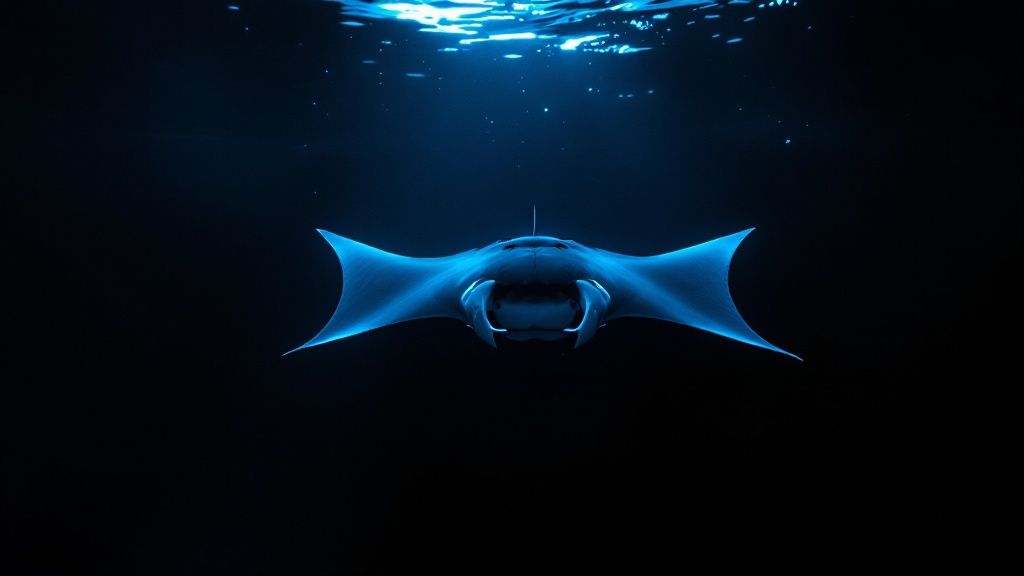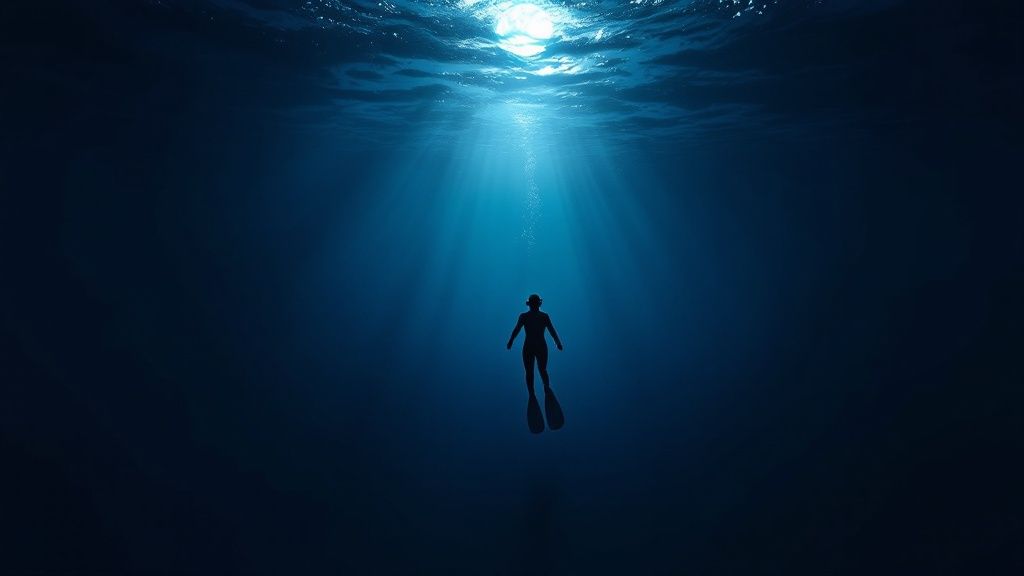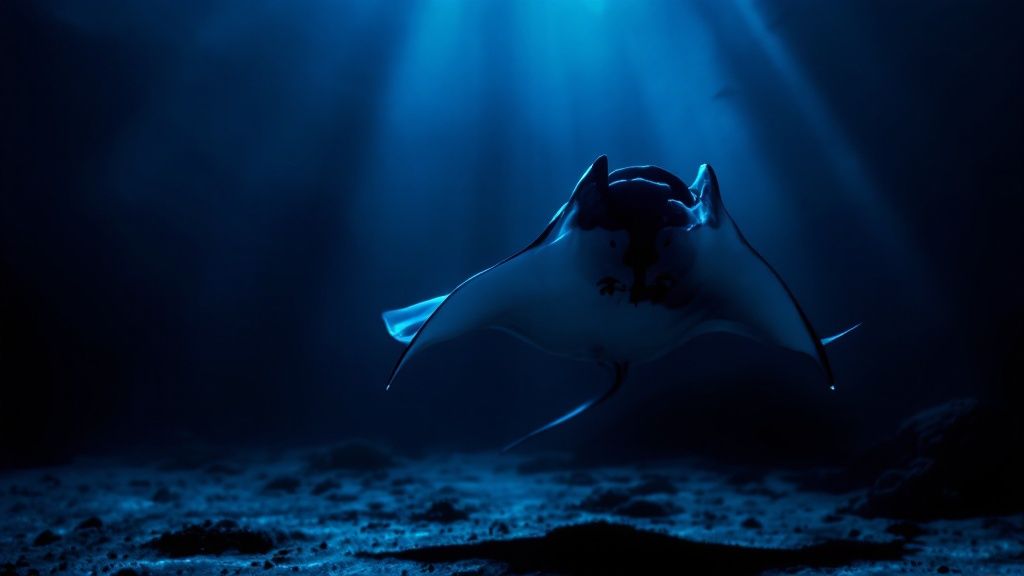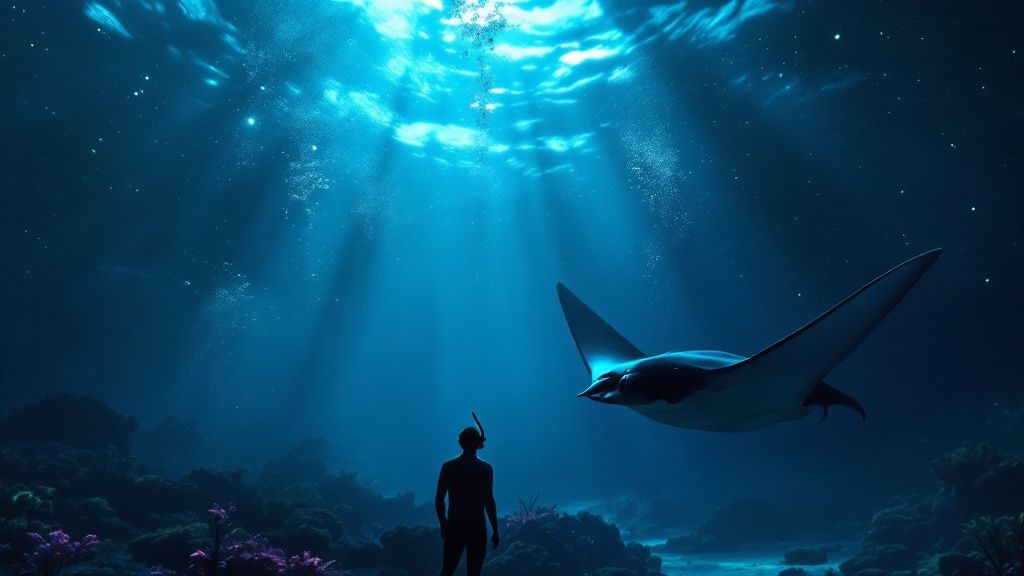Manta Ray Night Snorkel: Hawaiian Underwater Adventure
- Byron
- Apr 2
- 12 min read
The Magic of Manta Ray Night Snorkeling: Why It's Unmissable

Picture yourself floating on the ocean's surface under the twinkling Hawaiian night sky. Then, seemingly out of nowhere, enormous manta rays emerge from the darkness, their graceful movements mesmerizing. This is the allure of manta ray night snorkeling, a truly special encounter with these gentle giants.
The Allure of the Nighttime Encounter
Manta rays, with their vast wingspans, are filter feeders, consuming large amounts of plankton. This feeding habit is key to the nighttime experience. Tour operators strategically place specialized lights to create a concentrated plankton feast. This attracts the manta rays, bringing them closer to the surface for an exceptional view.
This unique approach facilitates safe and close interactions. For more information on related topics, explore our sitemap for other informative articles.
Kona: A Manta Ray Paradise
The Kona Coast of Hawaii is the perfect setting for these magical encounters. Its remarkably clear waters offer incredible visibility, allowing you to appreciate the intricate patterns on the underside of each manta ray. The unique underwater topography, with its natural channels and feeding grounds, enhances the experience even further.
Manta ray night snorkeling has become incredibly popular on the Big Island, attracting over 80,000 participants every year. It's one of the most sought-after marine adventures in the area. Learn more about the impact of these tours.
Why This Experience Is Life-Changing
Manta ray night snorkeling is more than just an activity; it's a truly moving experience. The sheer size and elegance of the manta rays, coupled with the mystical atmosphere of the nighttime ocean, evokes a sense of awe and wonder. Many first-time snorkelers describe the encounter as deeply emotional and unforgettable.
This explains why so many travelers return year after year, drawn back by the magic of these gentle giants. Several reputable tour operators in Kona offer this experience, including Kona Honu Divers, Manta Ray Night Snorkel Hawaii, Kona Snorkel Trips and Captain Cook Snorkeling Tours. These operators often have high success rates for manta sightings, making Kona a prime spot for this incredible adventure. The combination of clear water, abundant plankton, and professional lighting systems sets the stage for an unforgettable encounter.
Prime Manta Ray Viewing Locations You Can't Miss

The Kona Coast offers several exceptional spots for night snorkeling with manta rays. Each location has its own distinct characteristics that can truly elevate your experience. Choosing the right one can make all the difference in your encounter with these gentle giants.
Manta Village (Keauhou Bay)
Manta Village, nestled in Keauhou Bay, is a world-renowned location for manta ray night snorkeling. Known for its calm, shallow waters, this spot offers consistent manta ray activity. The sandy bottom provides a stable viewing platform, allowing snorkelers to easily watch the mantas' graceful movements. The bay's sheltered location usually means calm conditions, perfect for less experienced snorkelers and families.
Manta Heaven (Garden Eel Cove)
Manta Heaven, situated at Garden Eel Cove, truly lives up to its name. Boasting exceptionally clear water and frequent manta ray sightings, it's a favorite among enthusiasts. This location is easily accessible by boat, often involving a shorter trip from the shore. This translates to less travel time and more time enjoying the mantas. While the waters are generally calm, they can be a bit deeper than Keauhou Bay, making it suitable for those comfortable in slightly deeper ocean environments. Learn more in our blog posts.
Other Viewing Sites Along the Kona Coast
Beyond Manta Village and Manta Heaven, several other locations along the Kona Coast offer unique manta ray night snorkel experiences. These may include spots north or south of Kona, chosen by operators seeking less crowded waters. These alternative sites can provide a more private encounter, though manta ray sightings might be less frequent. Some tours depart from different points, resulting in varied boat journey lengths – an important factor to consider when choosing a tour.
To help you choose the perfect spot for your manta ray adventure, we've compiled a comparison table of the top locations in Kona:
Top Manta Ray Night Snorkel Locations in Kona Comparison of the main manta ray viewing sites with essential information for planning your trip
Location | Success Rate | Best For | Departure Point | Average Depth | Number of Mantas |
|---|---|---|---|---|---|
Manta Village (Keauhou Bay) | High | Beginners, Families | Keauhou Bay | Shallow | Varies, often numerous |
Manta Heaven (Garden Eel Cove) | High | Experienced Snorkelers | Honokohau Harbor | Moderate | Varies, often numerous |
Other Kona Coast Sites | Moderate | Private Encounters | Varies | Varies | Varies, potentially fewer |
This table summarizes the key differences between the primary manta ray viewing locations. As you can see, Manta Village and Manta Heaven offer high success rates, while other sites may be more suitable for those seeking a more secluded experience.
Choosing the Right Location for You
The ideal spot for your manta ray night snorkel depends on several factors, including your experience level, comfort in the water, and desired experience. For first-time snorkelers or families, the calm, shallow waters of Keauhou Bay (Manta Village) are often a great choice. More experienced snorkelers seeking larger groups of mantas might prefer Manta Heaven. Consider the boat journey length, especially if you're prone to seasickness. You might be interested in Manta Ray Night Snorkel Tours.
Researching tour operators like Kona Honu Divers, Manta Ray Night Snorkel Hawaii, Kona Snorkel Trips, and Captain Cook Snorkeling Tours can offer valuable insights into specific locations and experiences. This research can help you make an informed decision, ensuring an unforgettable manta ray night snorkel adventure. Careful planning will maximize your chances of a truly remarkable encounter with these magnificent creatures in their natural habitat.
Perfect Timing: When To Experience Manta Magic

Want to make the most of your manta ray night snorkel? Timing is key. While these graceful creatures are present year-round off the Kona Coast, a few factors significantly influence the quality of your encounter. Consider the moon phase, plankton activity, and ocean conditions to truly maximize your experience.
Decoding Seasonal Patterns for Manta Ray Encounters
Manta ray sightings are consistent throughout the year, but the experience itself can vary with seasonal changes. Water visibility and plankton abundance significantly affect your chances of a truly memorable encounter. While an average night might bring six manta rays, some nights boast over 36!
Peak summer months draw more tours due to calmer waters and plankton blooms. These conditions often lead to spectacular feeding frenzies with multiple mantas gathering at once. For more detailed information on seasonal manta ray viewing, check out this resource: What is the best time of year to see manta rays in Kona?.
The moon plays a surprising role, too. A full moon can scatter plankton, making it harder for mantas to feed in concentrated groups. A new moon, however, creates optimal darkness, drawing plankton to the surface and setting the stage for an unforgettable feeding display. For additional site information, you can also explore this page sitemap.
Navigating the Nuances of Time and Tide
Departure times are another crucial factor. While earlier departures near sunset might offer glimpses of other marine life, the real manta ray show begins after dark.
Tide patterns and currents are equally important. Some tides bring clearer water, enhancing visibility, while others can influence the mantas' movements. Understanding these nuances is essential for planning your adventure.
Working with a reputable tour operator can make a world of difference. Experienced operators understand these intricate details and can help you plan accordingly. Interested in similar experiences in other locations? Check out Florida Keys snorkeling tours.
Weighing the Seasonal Trade-Offs
Summer’s calm, warm waters are ideal for beginners. Winter, however, can bring more dramatic feeding displays due to shifting ocean dynamics.
Understanding these seasonal trade-offs allows you to tailor the experience to your comfort level. Experienced snorkelers might prefer the potential for increased manta ray activity during winter, while those new to snorkeling may appreciate the gentler summer conditions.
Choosing the right season can significantly enhance your adventure. Reputable operators like Kona Honu Divers, Manta Ray Night Snorkel Hawaii, Kona Snorkel Trips, and Captain Cook Snorkeling Tours can offer valuable insights into optimal viewing conditions and departure times. By understanding these factors, you can create a truly magical manta ray encounter.
Preparation Mastery: Setting Yourself Up For Success

Trading pre-snorkel jitters for excitement is the first step to a truly memorable manta ray night snorkel. Proper preparation is essential for both comfort and confidence, allowing you to fully embrace this unique experience. This involves knowing what to wear, what to bring, and what to expect once you’re in the water.
Essential Gear Considerations
Choosing the right gear significantly impacts your overall experience. Most tour operators, such as Kona Honu Divers, provide basic snorkeling equipment. However, bringing your own mask and snorkel can guarantee a comfortable, personalized fit, especially if you’ve had past issues with fogging or leaks.
A wetsuit is vital for warmth, especially on longer tours. Even in Hawaii’s warm waters, you can get cold after extended periods in the ocean at night. While many operators provide wetsuits, bringing your own ensures a perfect fit and added comfort.
Beyond the essentials, a few extras can enhance your experience. A towel and dry clothes for the boat ride back are crucial for warmth and comfort. If you are susceptible to seasickness, consider taking motion sickness medication beforehand.
Mastering Comfort and Confidence in the Water
For first-time night snorkelers, the darkness can be a little daunting. However, with mental preparation and a few simple techniques, any anxiety can be easily managed. Deep, slow breaths help regulate your nervous system and encourage relaxation. Focus on staying calm and trust the guidance of your experienced tour guides.
Remember, the guides are dedicated to your safety and enjoyment. If you begin to feel overwhelmed, communicate with your guide. They can provide extra support and even let you view the manta rays from the boat.
Positioning for Optimal Viewing
Proper positioning maximizes your manta ray viewing opportunities without disturbing these graceful creatures. Think about how underwater photographers and researchers position themselves: they stay still, avoiding sudden movements, to observe natural behavior. Employing a similar approach during your manta ray night snorkel gives you the best views while respecting these gentle giants.
Many tours use a stationary light board to attract plankton, which, in turn, attracts the manta rays. By holding onto the board, you remain still, allowing the mantas to come to you. This creates incredible viewing opportunities without requiring you to swim towards them.
To help you prepare, we've compiled a checklist of essential items:
The table below lists essential items for a comfortable manta ray night snorkel experience:
Item | Necessity Level | Typically Provided? | Notes |
|---|---|---|---|
Wetsuit | Essential | Usually | Consider bringing your own for a better fit |
Mask and Snorkel | Essential | Usually | Bringing your own can prevent fogging/leaking |
Towel | Essential | Sometimes | For warmth on the boat ride back |
Dry Clothes | Essential | No | For changing after the snorkel |
Motion Sickness Medication | Recommended if prone to seasickness | No | Take before departure |
Underwater Camera | Optional | Sometimes included in tour packages | For capturing memories responsibly |
Reef-safe Sunscreen | Recommended | No | Apply before the tour to protect yourself and the reef |
This checklist provides a quick overview of recommended items and whether they are typically provided by tour operators. Remember to confirm with your chosen tour operator regarding provided equipment.
By following these preparation tips, you’ll transform any pre-snorkel anxiety into excitement. This sets the stage for a truly magical and unforgettable manta ray encounter. For more information and booking, check out operators like Manta Ray Night Snorkel Hawaii, Kona Snorkel Trips and Captain Cook Snorkeling Tours.
Responsible Encounters: Conservation and Ethical Snorkeling
Experiencing a manta ray night snorkel is truly unforgettable. Adding an understanding of its role in conservation makes it even more rewarding. Responsible tourism is vital for protecting these gentle giants and their habitat. This ensures these magical encounters remain sustainable for generations to come.
How Tourism Supports Conservation
Responsible tourism plays a crucial role in manta ray conservation. Many operators contribute a portion of visitor fees directly to research and conservation projects.
This funding supports vital work like population monitoring, habitat protection, and educational programs. These initiatives provide crucial data that informs conservation strategies. Ultimately, these efforts protect these magnificent creatures. By choosing a responsible manta ray night snorkel tour, you're directly contributing to the well-being of these animals and their environment.
Choosing Responsible Operators
Not all manta ray tour operators are the same. It's important to distinguish between responsible operators and those who might cut corners. Operator commitment to sustainable practices is key.
Responsible operators adhere to strict guidelines. These include boat proximity to the mantas, limiting the number of snorkelers in the water, and promoting respectful interactions.
The Impact of Manta Ray Tourism
The economic and environmental impact of these tours significantly affects local communities and ecosystems. As of 2015, at least 42 commercial tour operators offered manta ray night snorkel experiences. This surge in popularity, partly due to 2020 legislation restricting dolphin interactions, highlights the growing demand for eco-friendly marine tours.
Increased tourism can present challenges. Overcrowding, sometimes with 28 boats and over 170 people in the water on a single night, is a concern. It emphasizes the importance of sustainable practices to ensure a thriving ecosystem. Choosing reputable tour operators dedicated to conservation is essential for maintaining the health of these environments. You can explore this topic further here.
Questions to Ask Before Booking
Before booking a manta ray night snorkel tour, ask some key questions. This will help ensure the operator prioritizes conservation:
What are their interaction guidelines?
How do they minimize their environmental impact?
Do they contribute to research or conservation efforts?
What is their group size limit?
These questions will help you assess the operator’s commitment to responsible practices. This will ensure your experience benefits both you and the manta rays. You may also want to check out Our Blog Posts Sitemap for more information.
Proper Interaction Guidelines
Understanding and following proper interaction guidelines is essential. This makes sure your manta ray night snorkel is a positive experience for both you and the animals.
Avoid touching the manta rays, as their skin is delicate and easily damaged. Maintain a respectful distance, allowing the mantas to approach you. Refrain from chasing or cornering them. Excessive splashing and loud noises can disturb these gentle giants. It’s important to maintain a calm and respectful presence in the water.
Recognizing Ethical Operations
Ethical manta ray tour operators prioritize animal welfare above profits. They demonstrate this through their actions and policies. This includes adhering to strict interaction guidelines, educating guests about manta ray conservation, and supporting research efforts.
Responsible operators also limit group sizes. This reduces overcrowding and minimizes disturbance to the mantas. They strive to create meaningful educational experiences that foster appreciation and respect for these incredible creatures. Operators like Kona Honu Divers, Manta Ray Night Snorkel Hawaii, Kona Snorkel Trips, and Captain Cook Snorkeling Tours offer great resources and booking options for ethical and sustainable manta ray night snorkeling. By choosing a responsible operator, you actively contribute to the long-term health of these magnificent animals and their ocean home.
Meeting Individuals: The Science of Manta Ray Recognition
Every manta ray gracefully navigating the ocean's depths during a manta ray night snorkel possesses a unique story. Each is a distinct individual, identifiable by unique markings, characteristic behaviors, and even a name bestowed by researchers. This intricate recognition process forms the foundation of modern manta ray research.
Nature's Fingerprints: Identifying Individual Mantas
The secret to distinguishing individual manta rays lies on their undersides. Like human fingerprints, each manta exhibits a unique pattern of spots and markings on its belly. These patterns remain consistent throughout the manta's life, providing a reliable means for researchers to track specific individuals over time.
This identification system enables scientists to uncover intimate details about their lives. These details include migration routes, social interactions, and even individual dietary preferences. Researchers might, for instance, discover that a particular manta prefers a specific type of plankton or frequently interacts with certain members of its social group.
The Power of Citizen Science: Contributing to Research
These individual identifications, based on unique spot patterns, empower researchers to monitor manta ray populations over extended durations. This collected data reveals insights into individual histories, migration routes, and social structures, offering information previously unavailable to science.
What's truly exciting is that you can contribute to this vital research! By sharing your photographs with research databases, you can add to the growing body of knowledge and even assist in tracking individual mantas over time. Imagine capturing a photo of a manta with a distinctive pattern during your night snorkel, and later, learning about its history and travels through a global database like Manta Matcher. The combined efforts of citizen scientists can significantly enhance our understanding of these magnificent creatures. You can find more information on our sitemap.
Dedicated Data Collection: Decades of Research
The collection of manta ray data depends on extensive observation and collaboration. Dedicated teams, including underwater camera professionals like Martina and James Wing, have played a crucial role in gathering statistics for decades. Through consistent video documentation at key Kona locations like Keauhou Bay and Manta Heaven, they have identified and tracked numerous manta rays.
This meticulous work includes detailed daily dive logs and thorough post-dive video reviews to ensure accurate reporting. This ongoing dedication has resulted in over 60 named manta rays, along with valuable insights into their migration and feeding habits. More detailed statistics can be found here.
Advanced Technologies: Enhancing Manta Ray Research
Beyond visual identification, emerging technologies are enhancing manta ray research. AI-powered image recognition software can quickly analyze photographs, automating the identification process. This speeds up research and allows scientists to focus on data interpretation. Satellite tracking projects are also monitoring the long-distance movements of mantas across entire oceans, revealing migratory patterns previously unknown. This gives scientists a better understanding of how mantas navigate vast distances and connect different populations.
Community Engagement: Protecting Mantas Through Understanding
This "citizen science" approach has significant implications for conservation. When people connect with individual mantas, they develop a deeper understanding and appreciation for these animals. This personal connection strengthens community investment in conservation initiatives, creating a powerful force for their protection. The future of these gentle giants depends on our collective understanding and commitment to their well-being. You can experience this connection firsthand on a manta ray night snorkel, knowing your experience directly supports their protection.
Book your unforgettable Manta Ray Night Snorkel Kona Hawaii Tour today and see the magic of these gentle giants for yourself! Experience the magic.
Comments